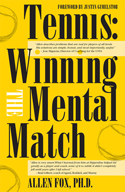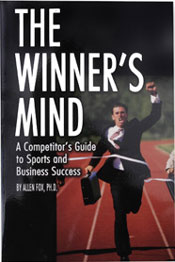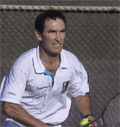Playing the Greats
Chuck McKinley: The Sky Rocket Career
By Allen Fox, Ph.D.
Chuck McKinley burst upon the tennis scene suddenly, and, like a brilliant fireworks display, lit the sky for a short time and was gone.
Chuck proved it doesn't take long to get very good at tennis if you have talent. An exceptional table tennis player, Chuck started to play tennis at the age of 13 and two years later reached the finals of the National 15-and-under division at Kalamazoo .
The next year, as one of the best 18-and-under players in the country, he was named to the U.S. Junior Davis Cup team, and by the age of 17 he was a threat to anyone in the world.
 |
Like a skyrocket Chuck McKinley rose to win Wimbledon in 1963, only 10 years after first
touching a racket. |
In 1961, at 20, Chuck was already a seasoned member of the U.S. Davis Cup team and a finalist at Wimbledon , where he lost to Rod Laver. In 1963, 10 years after first picking up a racket, Chuck was Wimbledon champion.
The only thing faster than Chuck's rise was his disappearance. By 1966 (at the age of 25) he had ended his tennis career and had embarked full time in the world of business. (What a loss to the game of tennis!)
Chuck was an exuberant, gifted dynamo who, at a muscular and stocky 5'7", was nicknamed "the stump" by the other players. He was also a great guy!
Two years older than Chuck, I grew up with him in the junior division and, like most of the other players who spent time with him, found him to be a fun loving, prank-playing, amusing wild man. He specialized in practical jokes - which HE thought were very funny -_ and they were, as long as he didn't play them on you.
You had to watch out if he was in the locker room. You might find your dress-clothes in the shower with you, a tub of ice water down your back, or he might decide to use your leg for a urinal. As annoying as these pranks might be, Chuck's bubbling good spirits, playfulness and simple joy of living made it hard to get mad at him.
When I was 19 the US Junior Davis Cup team lent a group of promising young players (including Chuck and me) a station wagon in which to tour some of the mid-western clay tournaments. Four of us drove it from Los Angeles to the first tournament in Little Rock , Arkansas , where we met up with the 17-year old McKinley.
 |
Chuck threw himself around the court with great speed and abandon. |
Right away Chuck began badgering us to let him drive. The rest of us were older than Chuck and knew him well enough to hesitate letting this little barbarian get behind the wheel. Our second evening in town Chuck finally talked his way into the driver's seat, promptly went speeding down a dark, Little Rock back street, and within three minutes was unable to make a turn and ran the car off the road where it got stuck in the middle of a muddy field.
It was a steaming hot summer night and squadrons of mosquitoes swarmed in for a fresh meal. We quickly rolled up the windows (cars were not air-conditioned in those days) and began to smack Chuck on the head for making us choose between sweating to death or being eaten by mosquitoes. Chuck was not without weapons. He retaliated by passing gas and laughing. How could anyone not love a guy like that!
On the tennis court Chuck oozed talent, and he was so powerful that he could whip the old heavy wood rackets around like a toothpick. He had incredibly strong wrists and could hit any shot imaginable. Particularly adept at spins (maybe a holdover from his early days as a table tennis player), Chuck rarely hit the same shot twice in a row.
Like virtually all of his contemporaries, he served and volleyed. But unlike them he was likely to hit tricky drop volleys from half court or take the occasional full swing on a high forehand volley. You never knew what shot was coming next.
His serve and overhead were strokes of imposing beauty. He was short, but a good jumper, and if he reached a lob it was gone. He hit overheads with shocking force and it was interesting, as a spectator, just to watch him make that ball move so fast.
Most players on the tour are not terribly interested in watching other players play. But watching Chuck was different. He hit the ball so beautifully, so cleanly and so imaginatively we all just liked to see him in action.
His tremendous wrists allowed him to impart searing amounts of spin to his serve and the ball took off violently when it hit the court. His action was fluid and quick, and he could hit the flat first serve with ungodly speed. But because he was so short it was a low percentage play for him and he didn't use it often. He just showed it once in awhile to keep you honest.
As you might imagine, small but powerful tank that he was, Chuck threw himself around the court with great speed and abandon. At his size, he had to be quick.
His most telling weakness was his size and it made him vulnerable to players like Roy Emerson, who also had a big game but who was taller, could hit a consistently heavier serve than Chuck, and had greater reach on the volley and overhead.
 |
Tremendous confidence and a champion's mentality helped Chuck come through when the stakes were highest. |
Still, Chuck was, on his good days, able to beat just about anybody, and was probably the second best player on the tour in his prime, after Roy Emerson. Manuel Santana was his equal on clay but was not as good as Chuck on grass, and Fred Stolle, the other great player on the tour, was close, but when they met in the finals of Wimbledon in 1963 and played for all the marbles, Chuck beat Fred in three straight sets.
Chuck had tremendous confidence and a champion's mentality. As Fred Stolle, a great competitor in his own right, found out, when the stakes were the highest Chuck was likely to raise his game.
Chuck played best on grass or clay, where his kick serve really took off and his variety of spins, drop volleys and power were most effective. He was not as good on the slick concrete of the time.
This is because his kick serve did not grab the court enough, and he was a little inconsistent on his low volley. I lost handily to Chuck the only time I played him on grass but beat him in our two meetings on concrete.
On grass his serve was difficult to return and his shot making kept me off balance. Because he was so strong in the wrists, Chuck could hit scrambling passing shots unexpectedly from positions that appeared almost hopeless, and the shock of this caused me to make more mistakes than usual. At the time I thought I lost because I played badly, but I didn't realize that I played badly because Chuck jerked me around so much.
On concrete, however, the story was different. Here his serve sat up and I could return it at his feet as he came in to net. On low first volleys the play on slick concrete was to hit the ball as deep as possible while making very few errors and close in to finish the point on the next shot.
Fortunately for me, Chuck was not good at this. Chuck liked to go for winners on the first volley or try difficult drop volleys. This caused him to make too many errors and was his undoing.
In our last meeting in 1962 he unveiled a new shot. It was a topspin lob, and I had never seen one. I think he got the idea from Santana, who was also experimenting with the shot in Europe at he same time, but it had not yet been introduced in the United States.
 |
Chuck's power combined with his temper could make him scary and a little dangerous. |
Chuck and I were playing in Tucson and the altitude and speed of the courts made it difficult for him to control these lobs. They all went short, and I was able to knock them off, but they did give me momentary pause. They had me fooled. I was moving forward when he hit them because they looked like passing shots.
Normal lobs are easier to read because the racket comes forward slowly and this tips off the volleyer to expect a lob instead of a passing shot. By contrast, with topspin lobs the racket comes forward fast, just as it does with passing shots.
Both shots look the same to the volleyer, and by the time you can tell the difference (by noting the trajectory of the ball), it is too late. Anyway, I mulled over the possibility that this could be a useful and dangerous shot. Naah, I concluded, it can 't be any good. Otherwise people would already have been using it.
Chuck was able to hit the ball so hard from awkward positions or running at full speed that he was actually scary and somewhat dangerous.
Chuck was dangerous because he had a little bit of a temper and occasionally took it into his head to try to hit at an opponent who, for whatever reason, irritated him. I saw him do it to Cliff Drysdale in a match at the Newport Casino tournament.
Cliff was beating Chuck on this day, leading by a set and a service break or possibly two breaks in the second, and Chuck was not happy. At that time Cliff had a very self-assured manner, which some players took to be haughty or cocky. (In fact Drysdale is not at all haughty, but rather a bright, talented and terrific guy who just might look haughty when he is giving you a good beating.)
In any case Drysdale hit a drop volley that landed a little too deep and Chuck came roaring in and hit what appeared to be a side-arm overhead on the dead run with bionic force. The ball was probably going at 130 miles an hour and, at a distance of about 10 feet, did not give Drysdale enough time to blink before it struck him on the forehead.
Had Cliff's head not gotten in the way the ball might have gone into orbit, so Chuck was obviously head-hunting rather than trying to hit the shot in the court. The force of the impact knocked Drysdale momentarily senseless and the ball ricocheted into the far reaches of the stadium.
The violence of the act shocked some of the watching fellow competitors and they were concerned that the ball might have seriously injured Cliff. As it was Cliff was so shaken that his game fell apart and he lost the match.
Chuck was also a great doubles player, winning the US Championship doubles three times as well as the Davis Cup Challenge round doubles in 1963 (over Roy Emerson/Neale Fraser) and in 1964 (over Roy Emerson/Fred Stolle) and an assortment of other US National Clay Court and Indoor titles.
Chuck was quick, strong and uniquely intimidating. I played against him in the doubles final of the Tucson Invitational tournament after beating him in the singles final and he was not a happy camper. Chuck did not exactly spend the match trying to hit me with the ball, but he did roar around whacking shots at tremendous velocities and if I happened to get in the way it was just going to be my tough luck.
 |
Later in life, Chuck seemed to lose the wondrous good fortune of his youth. |
Chuck had one particularly scary play. Returning serve in the backhand court, he would chip a soft, low return and come charging in to net faster than the server. By the time the server hit his first volley, Chuck was nearly on top of the net.
If the server's volley was at all high the server's partner was in grave danger. Chuck would, on the dead run, whip his racket around with a full swing and smack the ball right at the server's partner, who was, by now, at very close range. When my partner was serving to Chuck, I always felt very vulnerable because he could hit at me faster than my ability to react.
On one point Chuck made his usual chip and charge play, and my partner panicked and tried to lob-volley over the in-rushing Chuck. The lob was short, and, if there was ANYTHING that you absolutely HAD to avoid, it was giving Chuck a short lob when you were at close range with him at the net. (ESPECIALLY if he had just lost in singles.)
He hit me dead center in the stomach so hard that it nearly knocked the wind out of me, and I was black and blue afterwards for a week. That shot completely changed my outlook on the match. Instead of trying to win it, I now just wanted to get off the court without suffering further physical damage. Never before or after was an opponent able to make me that concerned about my safety on the tennis court.
Sadly, in his later years Chuck's life seemed to lose much of the wondrous good fortune that he always enjoyed on the tennis court. In his young years Chuck's spectacular rise seemed almost blessed. He was charming, the players liked him and he was a winner. In close situations where the stakes were the greatest, like the Wimbledon final in 1963 against Stolle, he usually came up with the marbles.
But his luck turned. Chuck put on weight and in his later years looked liked a puffed up caricature of his younger self. He still had the bouncy external personality, but the substantial extra weight struck me as indicative of some inner unhappiness, the cause or even certain existence of which I could not, at a distance, fathom. Ultimately his health failed and his life was cut tragically short. Chuck died in 1986 of brain cancer at the age of 45.






